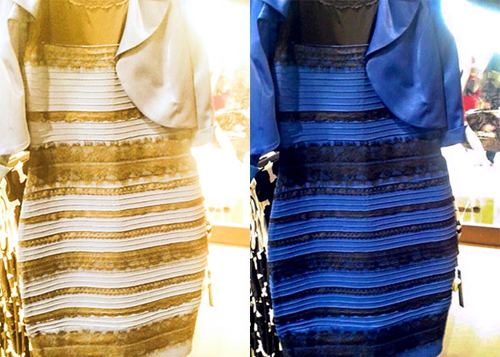Color Confusion
Permanent link All Posts
No matter how hard I looked, I just couldn’t see any black and blue in that damn dress.
I know, I know. We’re all sick of hearing about the (white and gold!) viral sensation that took the web by storm. (All things considered, however, I did prefer this to photos of Kim Kardashian’s naked and glistening derriere, which apparently “broke” the internet last year.)
But hear me out: besides being a head-scratching conundrum that inspired millions of quasi-hysterical emails and re-shares, there is something genuinely puzzling about this singular image. How can color, of all things, be a topic so disputed?
I dipped into a little research to see why this could happen. As it turns out, the things we see right before our very eyes are by no means undebatable.
Confused yet?
Take Homer, for instance – the poet, not the Simpsons character. For him, the issue of color truly was black and white – and I mean that literally. He only saw black and white, with a splash of red here and there, maybe a hint of green if he really strained his eyes. Of course, we have no way for sure of knowing what exactly the ancient poet saw as he scanned the Greek landscape, but judging by his writing, it’s very likely that he lived in a world that, at least to him, appeared rather colorless.
Homer is not alone, either. In most ancient texts, whether it be the Vedas or our very own Torah, color references aren’t as obvious as we might expect. Most interestingly, despite biblical texts’ innumerable references to the sky and the heavens, the color blue is not mentioned once. Never.
Blue is, in fact, humanity’s most modern color.
But the sky is blue. Isn’t it obvious? Yet, hundreds of years ago, this may have not been obvious at all. The color blue might have been there, but we humans were just unable to process, or even notice, it. It’s quite possible that, without a word or concept for blue, humanity might have just seen a colorless nothing as they gazed into the expansive mass of the sky.
This begs the question: How many other things are so obviously right in front of us, but we’re just unable to notice?
Take another example. About 150 years ago, a single terrifying thought kept hundreds of people awake at night, shivering nervously under their wool blankets and clutching to their loved ones. It was the overwhelming fear of being buried alive.
That might make sense for a couple extremely paranoid or naturally anxious individuals, but masses of people?
This was because back then, doctors didn’t have the medical prowess to differentiate between when someone had died or, say, simply lapsed into a coma, or drifted into unconsciousness, or suffered an epileptic attack. So the fear of being buried alive was actually quite legitimate. And the heartbroken relatives, ridden with grief, had no idea that their cause of despair was something they could still change. The solution was right there — they were just unable to see it.
As William Safire, New York Times columnist and Romanian-descended Jew, quips, “Never assume the obvious is true.”
Today, new pictures of the dress are making their rounds across the internet. Indeed, the dress is blue. But whenever I look back at that initial image, no matter how much I squint my eyes or print it out and turn it upside down, I always see gold.
What else is out there that I’m missing?
(For more info: Radiolab: “Colors;”Memory Palace)



.jpg)



